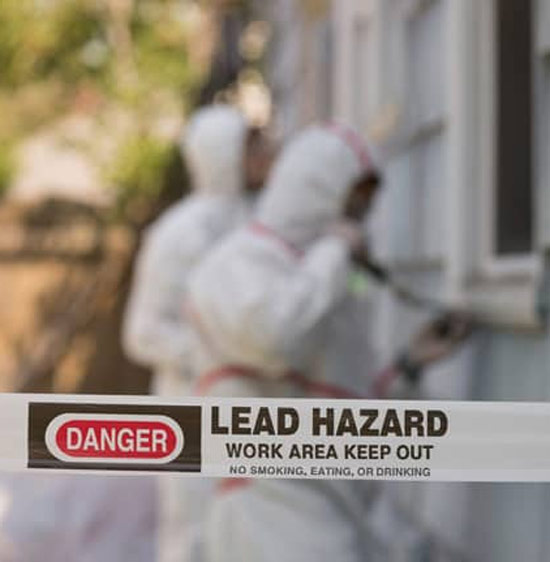Crucial Tools and Techniques for Efficient Lead Infraction Clean-up
Dealing with lead infractions successfully demands a thorough technique that blends the right tools with calculated methods. The initial step entails outfitting employees with Personal Safety Tools (PPE) to guard their wellness. Concurrently, using specialized cleanup tools, such as HEPA vacuums and lead-specific cleaning representatives, is vital for extensive pollutant removal. Reliable containment approaches, including plastic sheeting and adverse air stress systems, are vital to prevent the spread of dangerous materials. Safe disposal techniques and strict adherence to governing standards ensure responsible handling of poisonous waste. However what are the nuanced techniques that absolutely make a distinction?
Individual Safety Tools
Personal protective equipment (PPE) is an important part in the effective administration of lead contamination cleanup. The essential PPE for lead cleanup consists of respirators, safety clothing, handwear covers, and eye security.
Respirators, particularly those equipped with HEPA filters, are essential for filtering air-borne lead fragments, stopping breathing. Correct fit and seal checks are important to guarantee their performance. Protective garments, consisting of coveralls and non reusable suits, prevents lead dirt from sticking to workers' garments, lowering the threat of additional contamination. Gloves, usually made from nitrile or latex, shield the skin from direct contact with lead, while safety goggles or full-face guards safeguard the eyes from dust and debris.
In addition, extensive training on the correct use and maintenance of PPE is essential. Workers have to be informed on wearing and doffing procedures to avoid contamination. Routine inspections and substitutes of PPE elements are required to keep their protective capabilities, making certain a risk-free and compliant cleaning procedure.
Specialized Cleanup Equipment

Another crucial tool is the wet/dry vacuum cleaner, which can properly tidy up both dirt and liquid pollutants. These vacuums typically feature HEPA filters to supply an additional layer of security. Wet cleans or tack cloths are likewise crucial for surface cleaning; they are especially designed to capture and hold lead bits, decreasing the danger of spreading out contamination.
For even more persistent deposits, specialized lead-removal cleaning agents are required. These representatives are formulated to break down lead bits, making them much easier to get rid of. Scrub brushes with durable bristles can aid in this process, especially on harsh surface areas where lead dust often tends to stick extra strongly.
Additionally, encapsulants are used to seal lead-contaminated surfaces, protecting against the launch of lead dirt. These specialized paints and coverings are created to comply with numerous substratums, supplying a lasting remedy for lead containment.
Effective Control Techniques
Efficient control approaches are crucial in mitigating the web link spread of lead contamination throughout clean-up tasks. Implementing robust control approaches makes certain that lead fragments do not migrate to untouched areas, consequently securing both employees and the atmosphere. One main approach is making use of plastic sheeting to seal off polluted areas. Durable polyethylene obstacles can be set up from floor to ceiling to create a regulated workplace, dramatically decreasing the risk of airborne lead dirt dispersal.

To boost containment, encapsulants can be used to surfaces that are not being removed or interrupted. These specialized check it out finishes bind lead dust, reducing its availability for resuspension. In addition, all personnel must put on suitable Individual Safety Equipment (PPE), consisting of respirators and non reusable matches, to avoid contamination spread.
Safe Disposal Practices
Guaranteeing secure disposal methods is a vital part in the management of lead contamination cleaning. Correct disposal reduces the threat of lead returning to the setting and endangering public health and wellness (DOH & HPD Lead Violation Removal NYC).
Moving lead waste requires adherence to stringent standards. Making use of licensed contaminated materials providers makes sure that the materials are taken care of properly. Paperwork, consisting of manifests outlining the kind and amount of waste, need to come with deliveries to track the waste from the website of beginning to its last disposal location.
Designated hazardous waste disposal facilities are geared up to deal with lead-contaminated materials safely. These facilities commonly utilize innovative approaches such as stablizing, solidification, or chemical therapy to reduce the effects of the lead before disposal. Landfilling in specialized, lined areas that prevent leachate from infecting groundwater is an usual technique for last disposal.
Routine training for personnel involved in lead waste disposal is crucial to maintain security standards and stop unexpected exposure. By sticking to these techniques, organizations can considerably minimize the ecological and wellness effects related to lead contamination.
Regulatory Conformity Tips

Sticking to regulative compliance is critical in the effective execution of lead contamination cleanup. Recognizing and complying with federal, state, and neighborhood guidelines makes sure not only the safety and health of individuals however likewise the legal and monetary well-being of the clean-up organization. The Environmental Security Agency (EPA) establishes strict top article criteria, such as the Lead Renovation, Fixing, and Paint (RRP) Policy, which mandates proper accreditation and training for professionals handling lead-based tasks.
Compliance begins with a comprehensive evaluation of relevant laws and policies. Organizations needs to remain upgraded on any legislative changes, which can be facilitated via normal training sessions and subscribing to market updates. Documents is an additional essential compliance aspect; maintaining in-depth documents of all activities, including assessment records, worker training logs, and disposal shows up, is essential.
Furthermore, engaging with accredited lead inspectors or run the risk of assessors makes sure that lead threats are appropriately identified and mitigated. Employers must impose making use of Personal Safety Equipment (PPE) and ensure that safety protocols are strictly adhered to. Transparent communication with stakeholders, including staff members, customers, and regulatory bodies, will cultivate a society of compliance and responsibility, eventually contributing to a more secure and extra effective lead clean-up process.
Conclusion
Reliable lead infraction cleaning necessitates the integration of specialized tools and critical approaches to make certain safety and effectiveness. Individual safety equipment (PPE) safeguards workers from direct exposure, while secure disposal practices and stringent adherence to governing conformity are important for responsibly managing hazardous waste.